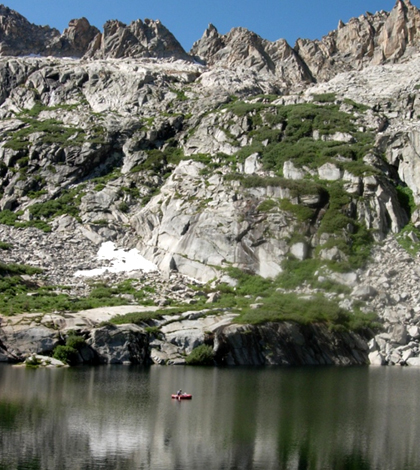High in the Sierra Nevada, lake temperatures more complicated than warming atmosphere

Measuring temperature in Emerald Lake in summer. (Credit: Craig Nelson)
Lakes are an important sentinel for climate change: They exist across the globe and they’re relatively sensitive to environmental shifts. But as a recent look at long-term data from a lake high in the Sierra Nevada shows, it takes more to change a lake’s temperature than a warming atmosphere.
A 20-year record of average water temperatures collected from Emerald Lake showed no clear trend, despite a slight increase in atmospheric temperatures across the same time period. The summer temperature did change from year to year, jumping from around 6 degrees Celsius one year and 14 degrees Celsius in another.
“There are big differences in the average temperature, but if that were caused by global warming we would be in trouble,” said John Melack, a contributor to the research and a professor in the Department of Ecology, Evolution and Marine Biology at the University of California, Santa Barbara.
The control on the lake’s temperature turned out to be how long it was covered in ice. Longer winters keep a frozen lid on the lake and shorten the amount of time it had to warm up in the winter.
“This sort of simplistic notion that air temperature really is what matters — there’s a lot more to what affects the temperature of a lake,” Melack said.
That often includes the goings-on deep into the water column — whether a lake stratifies and mixes, for example. That’s something that isn’t picked up by satellite-based measurements of lake temperatures, which have become an important tool for tracking changes across the globe. Those tools measure “skin temperatures,” only penetrating the top half-millimeter of water. The Emerald Lake temperature record, spanning 1991 to 2012, integrated the heat content of the entire like.
The record on Emerald Lake didn’t initially have anything to do with climate change, Melack said. It began with a project looking at acid rain, which turned out not to be a problem in California. The work there continued with a NASA-funded project on hydrology and snow-related issues. The procession of research eventually furnished a long-term record of average temperatures.

Emerald Lake temperature variations were related to the length of ice cover. (Credit: Craig Nelson)
It’s a somewhat rare record for high-elevation lakes, which can be difficult to access (especially in winter) and don’t often see year-round sampling. Emerald Lake sits five miles away from and two thousand feet above the nearest trailhead. It’s a manageable hike in the summer, but in winter the researchers have to strap on backcountry skis while carrying everything they’ll need to start doing science once they get to the lake.
Those provisions include an auger to drill down to liquid water. The ice that forms on the lake is an accumulation of layers of ice, snow and slush that build up over the winter to thicknesses that can be hard to predict.
“We’ve had as much as four or five meters of that kind of slush-ice stuff in a ten-meter-deep lake,” Melack said. Even a normal year produces two or three meters.
That variability can also make it tricky to deploy the temperature sensors that the researchers have installed there. Those include thermistors hanging from underwater buoys and sitting in the stream where water flows out from the lake.
The researchers will present their findings at the American Geophysical Union fall meeting in San Francisco.
Top image: Measuring temperature in Emerald Lake in summer. (Credit: Craig Nelson)




0 comments